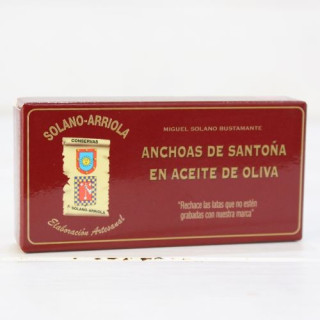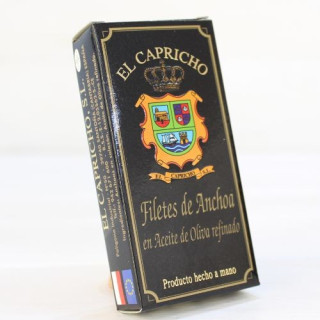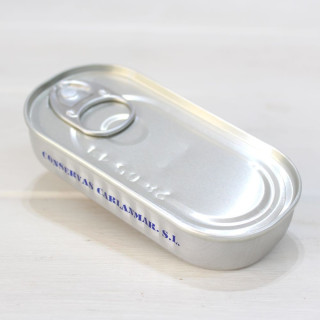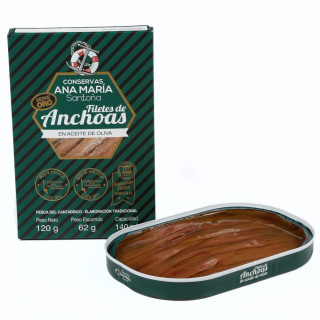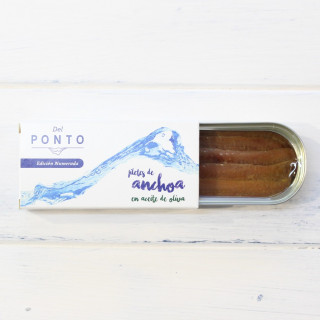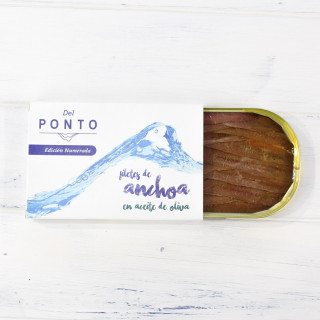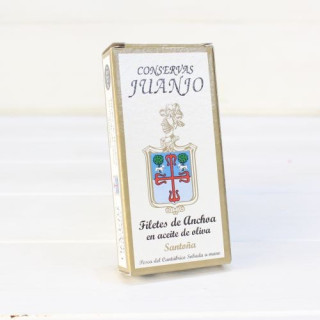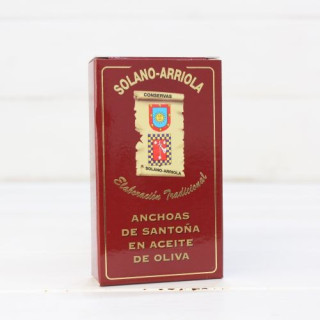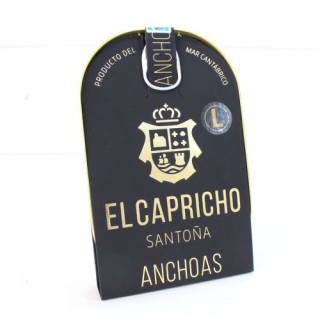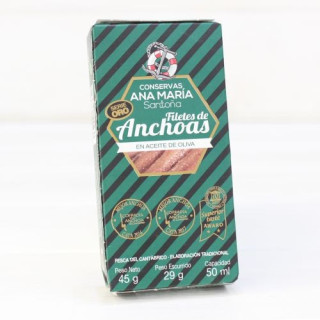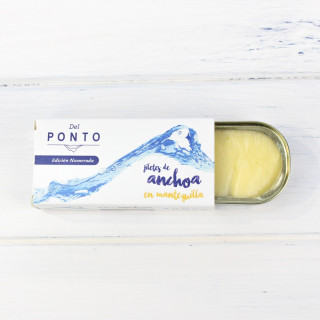Anchovies of Santoña
Now you can buy anchovies from Santoña of the best quality and with the best guarantee. All anchovies are 100% handmade, produced in Santoña, Cantabria.
We only select the best anchovies, from the cannery to your home. We are experts in Santoña anchovies, the first to have the widest selection of anchovies online and leaders in the sale of anchovies. We know each cannery, we guarantee the quality and freshness of each can. And we can offer the best prices for you to enjoy quality anchovies.
Varieties of Santoña Anchovies
The Santoña Anchovies are renowned for their exceptional quality and unmatched flavour. Although they all share a common origin in Santoña, one of the most prestigious places for anchovy production, factors such as the season in which they are caught or the techniques used in their production can influence their taste and texture.
We want you to enjoy the best that the Cantabrian Sea has to offer. Although the season of capture is not always specified for all seafood products, there is a secret about Santoña Anchovies that we want to share with you: the best anchovies are caught during the "anchovy season" between May and June. It is during this period that the fish reaches its peak flavour and freshness. If these anchovies reach the cannery as fresh as possible and undergo an artisanal production process, their quality is unparalleled.
Anchovies caught outside this season may be larger, but their flavour is fattier, placing them lower on the quality scale. We offer you the opportunity to enjoy the authentic, finest anchovies in the world.
Furthermore, Santoña Anchovies are marketed in various price ranges, but this difference is not necessarily related to a classification in varieties. Prices can vary depending on the artisanal process, the size of the anchovy, the type of packaging, or even the brand, but all share the same essence of quality that characterises the anchovies from this region.
What Santoña Anchovies can you find in this category:
Octavillos:
These are the smallest anchovies, perhaps the juiciest, weighing around 50 grams.
Double Octavillo:
The same as the octavillo but with more quantity for those who find a small can insufficient, weighing around 90 grams, with size varying very little.
Hansa or High-end Restaurant:
This format is what is typically served in bars as a tapa of anchovies, usually the largest size, very eye-catching, with around 12/14 anchovies depending on the cannery.
Panderetas:
The pandereta of anchovies is the round tin, available in sizes from 120 grams, 180 grams, 260 grams, and 550 grams. The anchovies are of medium size, corresponding to the diameter of the tin. Different sizes in similar tins can be found, with a lower price indicating smaller anchovies and a higher price indicating larger anchovies. More quantity means more anchovies.
20 Canning Brands
We offer the widest and best variety of Santoña Anchovy cans. We are the first and only ones to introduce you to the best and smaller producers who make the most exquisite anchovies.
Therefore, by choosing Santoña Anchovies, you can be assured of selecting a high-quality product, regardless of the price range or the season in which they were caught. The absence of an explicit distinction between varieties in no way affects the excellence that defines them but ensures a top-notch culinary experience in every bite.
Where to Buy Quality Santoña Anchovies
If you want to enjoy the authentic experience of Santoña Anchovies, it is important to purchase them from trusted establishments that guarantee the quality and origin of the product. In Santoña, you will find numerous shops and anchovy canneries where you can buy authentic Santoña Anchovies directly from local producers. These shops usually offer a wide variety of presentations and brands so that you can choose the one that best suits your tastes. You can also find quality Santoña Anchovies in gourmet and delicatessen shops, including our online store “AnchoasDeluxe” where we are experts in this product. These stores typically carefully select the products they offer, ensuring the excellence and authenticity of the anchovies. Before making your purchase, check that the anchovies are labelled as "Santoña Anchovies" and verify the origin and packaging date. This will ensure that you are buying a quality product and supporting local producers in Santoña.
¿How to Distinguish Anchovies from Boquerones?
The answer lies in their preparation method. Anchovies are famous for their maturation in salt, transforming into a salty, concentrated delicacy that captures the essence of the sea. In contrast, boquerones are marinated in fresh vinegar, offering a mild and tangy flavour, ideal for a variety of dishes.
In our AnchoasDeluxe product catalogue, we are proud to offer both types of preparation, respecting the traditions of our land in Santoña, Cantabria, and the Cantabrian coast.
Here, the term "anchovy" is applied only to salt-cured fillets, while the fresh fish is referred to as "bocarte".
Why are Anchovies from Santoña Caught in the Cantabrian Sea?
The origin of the anchovy in Santoña is linked to the Italians, particularly to a Sicilian family.
This family arrived in Santoña seeking new fishing grounds, as theirs in Italy were becoming depleted. They began spending more time in the area, not only during the fishing season, eventually settling in Santoña and establishing a factory with the idea of starting to sell anchovies directly cleaned and ready to eat, saving customers the task of cleaning them from the brine, which was how they had been sold until then.
Thus, Santoña eventually became one of the most productive areas in Europe and a benchmark for anchovies, becoming a way of life for its inhabitants.
The history of anchovy preservation in Santoña is a fascinating journey through time, from rudimentary preservation techniques to becoming a world-renowned industry. It all began in the 19th century when Giovanni Vella Scaliota, a Sicilian immigrant, arrived on the shores of Santoña and brought with him a revolutionary technique for preserving anchovies. This process, which included cleaning, salting, and pressing, allowed anchovies to be stored for long periods while retaining their freshness and flavour.
Over time, the preservation techniques for anchovies in Santoña were refined. More advanced methods were introduced, allowing for greater production without losing the quality that characterises this product. Over the years, Santoña became the epicentre of the anchovy industry, establishing itself as a global reference thanks to its dedication and respect for traditions. The combination of expertise, favourable climatic conditions, and an unwavering passion for quality has elevated Anchovies from Santoña to its current status.
Today, Santoña remains a leader in the production of high-quality anchovies. The evolution of preservation techniques has ensured that anchovies are recognised not only in Spain but worldwide. However, despite technological advances, many traditional salting and curing techniques are still used, ensuring that each anchovy fillet retains that authentic and distinctive flavour that makes it unmistakable.
Guide to Choosing the Best Anchovies from Santoña
When searching for high-quality Anchovies from Santoña, it is crucial to know the details that distinguish a good product. Anchovies from Santoña are not only famous for their exquisite flavour but also for a millennia-old tradition that has evolved primarily in its machinery and sanitary conditions. Here are some practical tips for selecting the best anchovies, ensuring you enjoy an authentic and delicious culinary experience.
1. Ideal Colour
A high-quality anchovy should have a uniform colour, tending towards a reddish-brown hue. This appearance suggests proper processing without blood spots or skin and with the central bone barely visible, signs of a well-made product.
2. Size and Shape
Look for anchovies with an elongated shape, not too trimmed or excessively large. The ideal size is around 13 centimetres, indicating they have not been artificially crushed to increase their size. Integrity in shape is a synonym for perfect texture.
3. Adequate Saltiness
Anchovies should have a hint of saltiness but not overpowering. Balanced saltiness enhances the flavour without dominating the palate.
4. Consistent Texture
The texture of the anchovy is key; it should be firm and consistent. Avoid those that are too soft or overly firm, as this may indicate improper processing or poor preservation.
5. Fresh Sea Aroma
The aroma of anchovies should remind you of the sea, not fresh fish. A good aroma is indicative of a fresh, high-quality product.
6. Bone Cleanliness
An exceptional anchovy will be free of bones, a result of meticulous work by experts ensuring a more enjoyable dining experience.
7. Intense and Pleasant Flavour
The flavour of the anchovies should be intense, leaving a lasting sea aftertaste that is highly pleasant and not overwhelming.
8. Balanced Fat
The amount of fat in anchovies is crucial and should be just right. This is achieved when the anchovies are caught during the coastal season, considered the best time of year for their capture, ensuring ideal flavour and texture.
By following these tips, you'll be on the right path to choosing the best Anchovies from Santoña, enjoying one of Spain's most traditional and refined flavours.
Discover the Process of Making Anchoas de Santoña
If you’ve ever wondered how Anchoas de Santoña are made, we invite you to explore the meticulous process behind these seafood delicacies, renowned for their excellent quality and taste. At AnchoasDeluxe, we take pride in showing you every step of the creation of these salted anchovies, highly valued for their quality and price.
1. Catching and Selection
Anchoas de Santoña are caught using sustainable fishing techniques during the spring, when the bocarte (local name for anchovy) has an ideal balance of fats, essential for preservation. At AnchoasDeluxe, we select only large bocartes, ensuring quality from the start.
2. Head Removal, Gutting, and Salting
Once at the factory, the bocartes are carefully head removed and gutted by hand. They are then placed in barrels with alternating layers of salt and anchovy. A weight is placed on top to gradually dehydrate the anchovies for at least six months, a process known as salting.
3. Deep Cleaning
The next step is to remove the skin and salt from each anchovy. At AnchoasDeluxe, this process is done entirely by hand, avoiding the use of hot water to preserve the integrity of the fish. This results in high-quality anchovy fillets.
4. Manual Filleting
The expert filletters at AnchoasDeluxe play a crucial role in this step. With skill and precision, they cut off the tails, remove the backbone, separate the fillets, and remove any remaining bones. This is a delicate task requiring experience and skill.
5. Packaging and Labelling
Finally, the anchovies are placed in their final container, oil is added, and they are individually packaged. Each package is labelled with the production date and the preferred consumption date, which is approximately eight months due to the low salt content.
Commitment to Quality
At AnchoasDeluxe, the exceptional quality of the raw material and rigorous quality control ensure a trusted and high-quality product. We have a specialised team dedicated to research and analysis to continuously improve the quality of all our anchovies in our gourmet store.
Discover why Anchoas de Santoña from AnchoasDeluxe are a benchmark for taste and quality from the Cantabrian Sea, offering an authentic and reliable product that satisfies even the most discerning palates.
Pairing Anchoas de Santoña with Wines and Other Products
Anchoas de Santoña are so versatile that they can be paired with a wide variety of wines and other products to enhance their flavour and enjoy a complete gastronomic experience.
When it comes to wines, anchovies pair very well with dry, fresh white wines, such as Albariño or Verdejo. These wines complement the salty flavour of the anchovies and provide a refreshing acidity that balances the intensity of the fish.
If you prefer red wines, opt for a light, fruity one, such as a young Tempranillo. The soft tannins and fruity flavours of this type of wine complement the smoky and herbaceous notes of the anchovies.
In addition to wines, Anchoas de Santoña can also be enjoyed with other products, such as mild cheeses, olives, crisp bread, and fresh tomatoes. These ingredients enhance the flavour of the anchovies and create an irresistible combination of flavours.
Experiment with different pairings and discover your favourite combinations. Anchoas de Santoña are so versatile that you are sure to find the perfect match to enjoy their unmatched flavour.
Discovering Types of Anchovies: An Essential Guide
Anchovies are a versatile and flavourful ingredient that adds a special touch to many dishes. Although various types are caught around the world, we will focus on the most notable ones, including the renowned Santoña anchovies. Here’s an overview of the main varieties you might encounter and how they differ in taste and texture:
- Peruvian Anchoveta: This type, similar to sardines, is caught in the temperate waters of the Pacific, reaching around 20°C. Its cooling process to 2°C and preservation in abundant salt gives it an intense flavour and a slight metallic aroma. With its rounded, short body covered in many scales, it is ideal for enhancing dishes such as pastas and pizzas, where its powerful flavour truly shines.
- South Atlantic Anchovy: Originating from Argentina, Uruguay, and Brazil, this anchovy is slender and elongated, closely resembling local varieties but distinguished by having a more robust spine that requires meticulous cleaning to avoid issues when consumed. Its texture is perfect for emulsions in oil and butters, making these anchovies an exceptional ingredient for recipes requiring thorough coverage.
- Mediterranean Anchovy: Caught from the North Atlantic to the Black Sea, including the vast Mediterranean, this variety is slightly smaller than those from the Cantabrian Sea and its flavour is less intense. Its similar characteristics make it a popular choice among anchovy enthusiasts.
- Cantabrian Anchovy: The crown jewel among anchovies, this variety is highly prized for its fine aroma, distinctive reddish colour, and delicate texture. Key factors such as diet and the temperature of the turbulent waters of northern Spain contribute to its exceptional quality.
- The Santoña Anchovies, scientifically known as Engraulis encrasicolus, are a true gastronomic treasure from the Cantabrian region. These small but flavourful anchovies are renowned for their superior quality, and when the label mentions this specific species, you can be assured you are purchasing a top-quality product.
The Cantabrian anchovy is not only found in Spanish waters but also in varied locations such as the Mediterranean, the Atlantic coast of Africa, and the Black Sea. However, the most prized come from FAO area 27, particularly the Bay of Biscay, where fishing takes place in the Cantabrian Sea. This area is renowned for providing some of the most exquisite anchovies on the market, noted for their freshness and authentic flavour.
These fish are relatively small, measuring between 15 and 20 centimetres, but don’t be deceived by their size. They have a delicate scale and a coloration ranging from deep green to bluish-grey, with a distinctly silver belly. One of the most fascinating aspects of anchovies is their spawning cycle, which occurs between May and July, a period during which the fish's quality reaches its peak.
When choosing Santoña Anchovies, you are not only opting for an ingredient of excellent quality but also supporting sustainable fishing practices in one of the most renowned regions for its commitment to marine environment preservation and product quality. Whether enjoyed on their own, as part of a tapa, or in a more elaborate recipe, Santoña Anchovies offer a flavour that is simply unmatched.
When buying, make sure to look for the mention of Engraulis encrasicolus on the label to ensure you are bringing home an authentic and top-quality product. Enjoy the exceptional Santoña Anchovies at your next meal!
Santoña Anchovies versus Other Anchovy Varieties
It is important to highlight that Santoña Anchovies differ from other anchovy varieties by their unique flavour and careful production process.
Santoña Anchovies are known for their balanced, slightly salty and smoky flavour, with fresh and herbaceous notes. Their delicate and soft texture sets them apart from other anchovy varieties, which may have a stronger taste and a more fibrous texture.
Moreover, Santoña Anchovies are crafted in an artisanal manner by skilled fishermen, using sustainable and environmentally friendly fishing methods. This ensures the freshness and quality of the final product, as well as the preservation of the anchovy species.
Although other anchovy varieties are available on the market, Santoña Anchovies are globally recognised as a benchmark of exceptional quality and flavour. Don’t settle for imitations and enjoy the authentic experience of Santoña Anchovies.
Discover Santoña Anchovies: A Taste with History and Tradition
In the picturesque town of Santoña, located in northern Spain, a revolution in fish preservation took place thanks to Giovanni Vella Scaliota. This innovative Sicilian, hired by Angelo Parodi in 1880, forever changed the fate of anchovies with his ingenuity. In 1883, he created a technique that would allow for easier and longer enjoyment of this fish: anchovy fillets in oil.
The process of preparing anchovies in brine, which Vella Scaliota inherited and refined, is an art requiring precision and care. First, the fish are thoroughly cleaned, removing any impurities. Traditionally, anchovies are enjoyed plain, enhancing their intense flavour with a touch of butter to soften the saltiness. However, this method presented a challenge: the need to consume the anchovies shortly after preparation.
Faced with this limitation, Vella Scaliota had a vision: to industrialise the process. In his factory in Santoña, he began implementing a system where everything was done under one roof: from meticulous cleaning to precise filleting, removal of the central bone, and finally, canning. This approach not only increased production but also allowed anchovies to be preserved for much longer, facilitating their distribution and sale to a wider consumer base.
The success was overwhelming, and today Santoña Anchovies are renowned for their quality and unique flavour. This artisanal process, combined with modern preservation techniques, ensures that every tin of Santoña Anchovies reaching your table retains the authentic taste of the Cantabrian Sea.
When looking for a product that encapsulates tradition, flavour, and quality, look no further than Santoña Anchovies. They are more than just an ingredient: they are a piece of culinary history ready to be enjoyed.
Where can I find the largest Santoña anchovies?
The highest quality anchovies come from the spring season, when the anchovy (bocarte) approaches the shores to spawn. Therefore, their size is medium, with very few exceptions. With the best quality, we will find only small and medium anchovies. When processed, the largest ones are separated to be canned in high-end formats, where you will rarely find more than 10 fillets. Nowadays, the usual count is 12/14/16 fillets per tin, as the large size is becoming very scarce in each Santoña anchovy campaign.
What is the most suitable Santoña anchovy format?
When purchasing anchovies, you should select the format based on how you plan to consume them.
• 50g octavillo with 8/9 fillets: This is the most suitable if you are consuming them alone or with one other person.
• Double octavillo of 95g with approximately 16 fillets: Ideal for sharing among 3-5 people.
• Large tins or extra large with 12-14 anchovies: For meals with several diners or fans of large fillets.
The number of diners may vary depending on the use of the anchovies, whether they are served as a starter, main course, or part of a side dish.
You may also purchase anchovies by brand. If you are unfamiliar with any, it is best to enjoy one or more for a tasting, as none will disappoint. Each has its nuances, but all these anchovies are true delicacies.
Tips for preserving Santoña anchovies
Santoña anchovies should always be kept in the refrigerator until consumption. When you want to enjoy them, take them out 15-20 minutes beforehand so that the oil and salt dissolve from any possible solidification due to the cold.
Anchovies should be opened and consumed in their entirety. Light and air will dry out the remaining ones, and they will not be in the same condition as the first ones.
Whenever possible, anchovies are best preserved and presented in a tin format, which offers better shelf life and presentation due to its horizontal shape, making it easier to arrange.
The tin protects the anchovies from light, air, and the vapours that can develop in a glass jar.
Another option is to use special oils for preservation. By immersing anchovies in high-quality olive oil, not only is their freshness protected, but their flavour is also enhanced. It is important to ensure that the anchovies are completely covered by the oil to avoid contact with air, which could speed up deterioration.
If you have already opened a jar or tin of anchovies, it is essential to keep them in the refrigerator. Depending on conditions, they may last from 1 to 3 weeks. Their colour will darken due to air exposure and will only lose quality over time.
Specific Recipes and Culinary Uses of Santoña Anchovies
Santoña anchovies are a fundamental ingredient in various gourmet recipes, thanks to their exceptional quality and unique flavour. These anchovies can be incorporated into a wide range of dishes, from appetizers to main courses, always adding a distinctive touch that elevates any recipe.
One of the simplest and most delicious ways to enjoy Santoña anchovies is in a anchovy toast with crispy bread, butter, and a hint of garlic. This dish, though simple, allows you to fully appreciate the authentic flavour of the anchovies.
Another classic recipe is the tomato and anchovy salad, where the combination of fresh ingredients such as tomato, onion, and olive oil, along with Santoña anchovies, creates a perfect harmony of Mediterranean flavours.
For pasta lovers, an excellent option is to prepare pasta with Santoña anchovies and capers. This dish is a clear example of how anchovies can transform a simple recipe into a culinary delight, adding depth and character to the flavour.
Finally, we cannot forget the anchovy pizza, a classic that combines the intense flavour of anchovies with the creaminess of cheese and the acidity of tomato sauce, creating a perfect balance that pleases any palate.
Santoña anchovies not only shine in traditional recipes but are also perfect for experimenting in modern cuisine, allowing chefs and enthusiasts to create innovative dishes with a touch of the sea.
Santoña anchovies are a true delicacy that not only stands out for their exquisite flavour but also for their exceptional nutritional profile. This seafood product, highly valued in the Mediterranean diet, offers a range of health benefits that make it an essential food.
Nutritional Benefits of Santoña Anchovies
Anchovies are a rich source of omega-3 fatty acids, which are essential for maintaining cardiovascular health. Omega-3s help reduce blood cholesterol and triglyceride levels, which contributes to preventing heart disease. Moreover, regular consumption of anchovies can improve brain function and reduce inflammation in the body.
In addition to fatty acids, Santoña anchovies are an excellent source of high-quality proteins. These proteins are crucial for tissue repair and building, as well as for enzyme and hormone production in the body. Therefore, including anchovies in the diet is an excellent way to ensure an adequate protein intake, especially for those following a diet based on high-quality animal products.
Another notable aspect of the nutritional profile of Santoña anchovies is their content of essential minerals such as calcium, iron, and magnesium. These minerals play a crucial role in various bodily functions. Calcium is vital for bone health, iron is essential for red blood cell formation and oxygen transport, and magnesium participates in over 300 biochemical reactions in the body, including muscle and nerve function regulation.
Finally, we cannot forget that anchovies are also low in calories, making them a healthy option for those looking to maintain or lose weight without sacrificing flavour. Their low saturated fat content and high nutritional density make this fish a perfect ally in any balanced diet.
Market Trends and Anchovy Consumption
In recent years, the anchovy market has experienced notable growth, driven by the increasing demand for gourmet and high-quality products. Consumers, who are becoming more discerning, seek foods that are not only tasty but also offer a unique culinary experience. This has led to a rise in the popularity of artisanal anchovies, produced using traditional methods that ensure exceptional flavour and texture.
Today, anchovies are not only consumed as a simple snack but have found their place in fine dining, where renowned chefs incorporate them into sophisticated dishes, highlighting their intense umami flavour. This trend has led to the emergence of new brands and a diversification of offerings, with products that stand out for their quality and origin. Furthermore, the rise of healthy eating has positioned anchovies as a nutrient-rich option, noted for their high omega-3 and protein content.
The anchovy market also reflects an increased awareness of the origin and sustainability of seafood products. Today's consumers value the provenance of anchovies, preferring those from areas with sustainability certifications, such as those from the Cantabrian Sea. This trend has led to greater transparency in the supply chain and encouraged responsible fishing practices, contributing to the conservation of marine species.
Preserving and storing anchovies is crucial for maintaining their freshness and quality over time. Santoña anchovies, known for their exceptional flavour and smooth texture, require special care to ensure they retain all their organoleptic properties.




